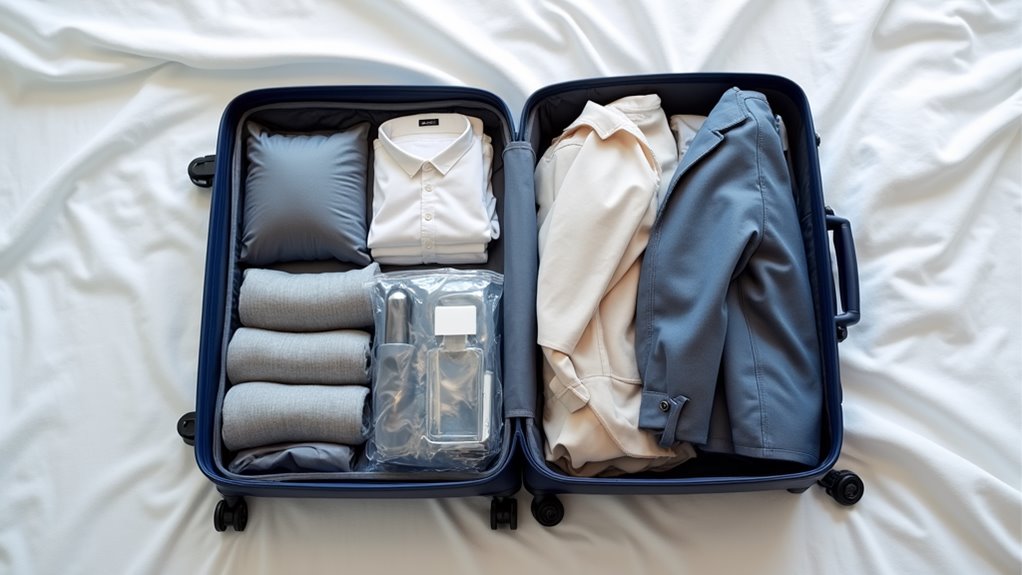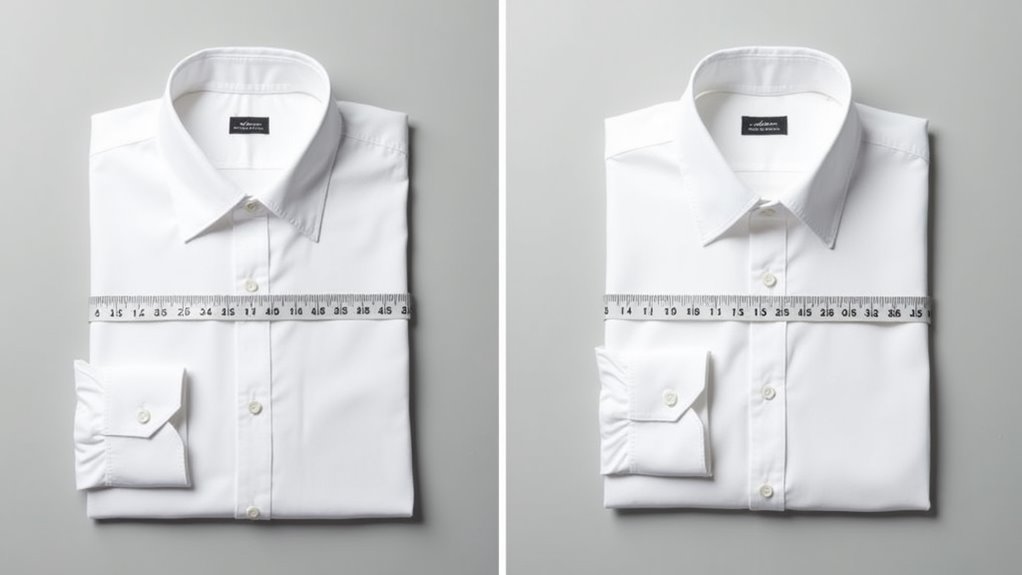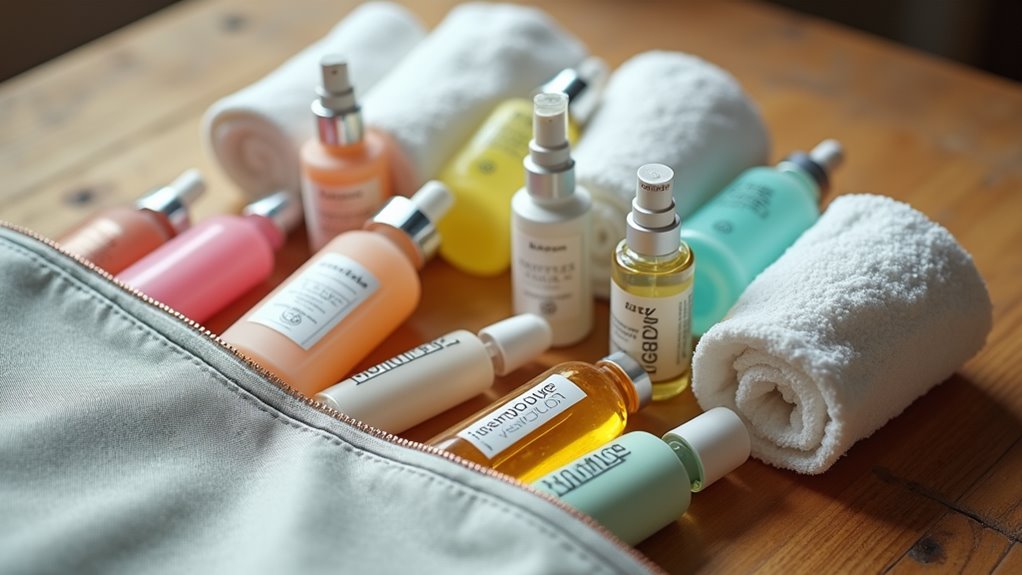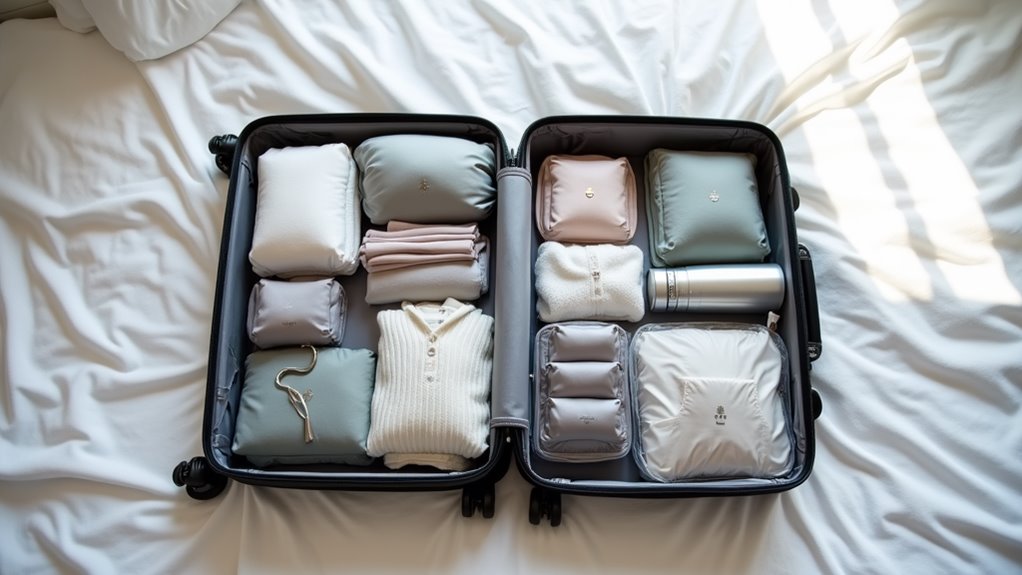You'll master carry-on packing by starting with the right bag – one that meets airline size limits while offering smart organization. Choose versatile, neutral-colored clothing that can create multiple outfits, and roll soft items while folding structured pieces to maximize space. Pack efficiently by stuffing socks in shoes, using compression bags for bulky items, and keeping toiletries travel-sized. Store your electronics and important documents in easily accessible compartments, and always create digital backups of essential paperwork. These core strategies will transform you from an over-packer into a light travel expert.
Key Takeaways
- Choose a lightweight carry-on bag within airline size limits (22 x 14 x 9 inches) made from durable materials like polycarbonate.
- Pack versatile clothing pieces in neutral colors that can create multiple outfits and coordinate with just two pairs of shoes.
- Roll soft clothes tightly and fold structured garments, utilizing compression bags to minimize space and reduce wrinkles.
- Fill empty spaces strategically by stuffing socks in shoes and using mesh compartments for smaller, frequently needed items.
- Pack only essential electronics and keep important documents together in a waterproof pouch with digital backups stored online.
Choose The Perfect Carry-On Bag

When selecting a carry-on bag, you'll need to balance size restrictions with functionality. Most airlines limit carry-on dimensions to 22 x 14 x 9 inches, so choose a bag that maximizes this space while meeting requirements.
Look for lightweight materials like polycarbonate or ballistic nylon to avoid adding unnecessary weight.
Consider a bag with multiple compartments and exterior pockets for easy access to essentials. Wheels should be durable and smooth-rolling, with spinner wheels offering the best maneuverability.
If you're choosing a backpack-style carry-on, ensure it has padded straps and proper weight distribution. The handle should be sturdy and adjustable, allowing comfortable navigation through crowded terminals.
Don't forget to check that zippers are heavy-duty and water-resistant to protect your belongings.
Smart Clothing Selection and Coordination
Because clothing takes up the most space in your luggage, smart selection is crucial for light travel.
Choose versatile pieces in neutral colors that you can mix and match to create multiple outfits. Pack items that serve dual purposes, like a dress that works for both day and evening wear, or pants that can be dressed up or down.
Stick to the "rule of three" – pack clothes you can wear at least three different ways.
Select wrinkle-resistant fabrics that roll compactly, and opt for lightweight layers instead of bulky items. Plan your outfits around a single color scheme, and limit yourself to two pairs of shoes that complement all your choices.
Remember: each piece you pack should coordinate with at least three other items in your travel wardrobe.
Rolling vs. Folding Methods

While both rolling and folding clothes have their merits, rolling typically saves more space and reduces wrinkles in most garments. You'll find this method works best with softer items like t-shirts, pants, and casual dresses.
Roll each piece tightly from one end to create compact cylinders that you can easily stack or place side by side.
For structured items like blazers and dress shirts, stick to traditional folding techniques to maintain their shape. You can also try the bundle method, where you wrap clothes around a core item to minimize creases.
If you're packing both rolled and folded items, place the folded pieces at the bottom of your bag and arrange the rolled items on top for optimal organization and space efficiency.
Maximizing Every Inch of Space
Since every square inch counts in a suitcase, you'll need clever strategies to utilize all available space. Start by stuffing socks and underwear inside your shoes, and tuck small items like chargers and accessories into any gaps between clothes.
Use compression bags to squeeze out excess air from bulky items like sweaters and jackets.
Make the most of hollow spaces in your toiletry bottles by only packing what you'll actually use during your trip. Stack similar-sized items together, and place heavier objects at the bottom of your bag to maintain stability.
Don't forget to use the mesh pockets on the inside of your suitcase's lid for thin items like documents or a tablet. These simple techniques will help you fit more while keeping everything organized and accessible.
Travel-Sized Toiletries That Work

Efficient packing extends beyond space-saving to smart choices in toiletries. You'll need to strike a balance between bringing enough products for your trip while meeting airline restrictions for liquids.
Choose concentrated formulas that pack more uses into smaller containers, like solid shampoo bars and multipurpose cleansing sticks.
Don't waste space with hotel-provided basics like soap and shampoo unless you're particularly sensitive to different products. Instead, focus on must-have items you can't easily find at your destination.
Consider refillable silicone bottles for your favorite products, and look for dual-purpose items like tinted moisturizer with SPF or combination shampoo-conditioners.
Remember to check that bottle caps are secure and pack liquids in sealed plastic bags to prevent messy spills in your luggage.
Essential Electronics and Documents
Before heading out on your journey, gather essential electronics and documents in a single, easily accessible location. Pack your phone, charger, adapter, and portable battery pack to stay connected.
Don't forget your laptop or tablet if you'll need them for work or entertainment.
Keep your passport, ID, travel insurance cards, and boarding passes in a waterproof pouch or document organizer. Make digital copies of these items and store them in your cloud account or email them to yourself as backup.
If you're traveling internationally, include necessary visas and vaccination records. Bring only the credit cards you'll use and alert your bank about your travel dates.
Consider carrying a small notebook with emergency contacts and important addresses written down in case your devices fail.
Frequently Asked Questions
How Do I Pack Gifts and Souvenirs Without Adding Extra Baggage?
Pack lightweight, flat items like scarves, postcards, or local crafts that won't take up much space.
You'll save room by choosing small, meaningful souvenirs over bulky items.
Roll clothing tightly and use compression bags to create extra space.
Consider shipping larger gifts home separately or buying easily packable items like jewelry, spices, or local sweets that fit into small spaces.
Can I Bring Food and Snacks in My Carry-On Bag?
You'll save a mountain of money by bringing your own snacks on flights!
Most solid foods are allowed in your carry-on, including sandwiches, chips, fruit, and granola bars. Just avoid liquids over 3.4 ounces and foods with high liquid content.
Pack snacks in clear, resealable bags for easy security screening.
If you're flying internationally, you'll need to finish or toss any fresh produce before landing.
What Should I Do if My Carry-On Is Overweight at Check-In?
If your carry-on is overweight, you'll need to act quickly.
You can transfer heavier items to your personal item, wear bulkier clothing pieces, or buy a small bag at the airport shop to redistribute weight.
As a last resort, you might need to check your bag and pay the fee.
To avoid this next time, weigh your bag at home before heading to the airport.
How Do I Handle Wrinkled Clothes Without Access to an Iron?
You can smooth out wrinkled clothes using several quick methods.
Hang garments in the bathroom while taking a hot shower – the steam will help release creases.
Roll clothes tightly instead of folding them to prevent wrinkles in the first place.
For stubborn wrinkles, dampen the garment slightly and use a hair dryer to dry while smoothing with your hands.
You can also use wrinkle-release spray from most drugstores.
Are Compression Bags Worth the Investment for Carry-On Travel?
Compression bags can be a game-changer for your carry-on travel.
You'll save up to 80% of space by removing excess air from bulky items like sweaters and jackets. They're especially useful for winter travel or longer trips.
However, remember that compressed clothes tend to wrinkle more, and the bags add extra weight.
Consider getting a few quality bags rather than a full set.
Conclusion
You'll be amazed how traveling light can transform your entire journey. With these carry-on packing strategies, you're joining the 58% of travelers who now skip checked baggage fees and avoid lost luggage hassles. By selecting versatile clothing, mastering efficient packing techniques, and bringing only the essentials, you've got everything needed for stress-free adventures. Now you're ready to explore without being weighed down.

Leave a Reply